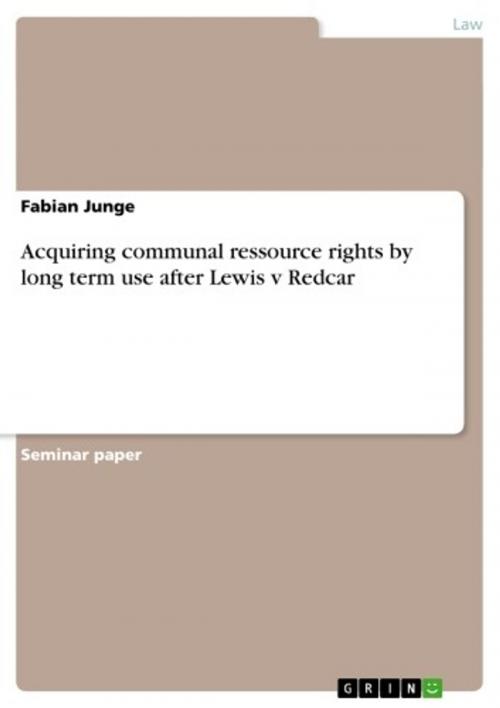Acquiring communal ressource rights by long term use after Lewis v Redcar
Nonfiction, Reference & Language, Law, Urban State & Local Government| Author: | Fabian Junge | ISBN: | 9783656003946 |
| Publisher: | GRIN Verlag | Publication: | September 12, 2011 |
| Imprint: | GRIN Verlag | Language: | English |
| Author: | Fabian Junge |
| ISBN: | 9783656003946 |
| Publisher: | GRIN Verlag |
| Publication: | September 12, 2011 |
| Imprint: | GRIN Verlag |
| Language: | English |
Seminar paper from the year 2011 in the subject Law - Public Law / Administrative Law, grade: 2,0, Carl von Ossietzky University of Oldenburg, language: English, abstract: To work out the details on how to acquire communal resource rights by long term use we first have to examine the question what are communal resource rights exactly. Due to the fact that there is no possibility for a community to own land or to hold fee simple estates in land, English Law has developed limited access 'communal property rights'. These rights can be exercised over areas known as commons. Commons have their origin in the agricultural tradition that has been established in the late 11th century to use the harvested fields together for common grazing of the animals of all members of a locality. Out of these local customs evolved the so called 'rights of common' as part of the communal property rights. They are held by distinct individuals of a community and include rights such as fishing, grazing or to collect firewood which can be asserted by them. Over time, the use of particular rights of common decreased due to the industrialization. The changing reliance of the people on certain resources such as timber and the second communal property rights called customary rights of fluctuating bodies gained in importance. They can only be acquired by custom or by long use and have the peculiarity that they can be exercised, once they have been established, by anybody independently of ownership as long as he belongs to the particular local community. One of the most frequently exercised customary rights is the right of recreational use on which this paper puts the focus on. This use has been very limited in the history of English law, but in the 13th century some land has been increasingly used by the local inhabitants for recreation or sports and the courts started to declare a land as town or village green with protection from interference if a long term use could be verified. Since the 19th century the centre of gravity shifted from the agricultural benefits of town or village greens to the recognition of the large general public interest in recreation and the countryside. This development culminates after various other statutory provisions in favor of the protection of town or village greens in the Commons Registration Act in 1965.
Seminar paper from the year 2011 in the subject Law - Public Law / Administrative Law, grade: 2,0, Carl von Ossietzky University of Oldenburg, language: English, abstract: To work out the details on how to acquire communal resource rights by long term use we first have to examine the question what are communal resource rights exactly. Due to the fact that there is no possibility for a community to own land or to hold fee simple estates in land, English Law has developed limited access 'communal property rights'. These rights can be exercised over areas known as commons. Commons have their origin in the agricultural tradition that has been established in the late 11th century to use the harvested fields together for common grazing of the animals of all members of a locality. Out of these local customs evolved the so called 'rights of common' as part of the communal property rights. They are held by distinct individuals of a community and include rights such as fishing, grazing or to collect firewood which can be asserted by them. Over time, the use of particular rights of common decreased due to the industrialization. The changing reliance of the people on certain resources such as timber and the second communal property rights called customary rights of fluctuating bodies gained in importance. They can only be acquired by custom or by long use and have the peculiarity that they can be exercised, once they have been established, by anybody independently of ownership as long as he belongs to the particular local community. One of the most frequently exercised customary rights is the right of recreational use on which this paper puts the focus on. This use has been very limited in the history of English law, but in the 13th century some land has been increasingly used by the local inhabitants for recreation or sports and the courts started to declare a land as town or village green with protection from interference if a long term use could be verified. Since the 19th century the centre of gravity shifted from the agricultural benefits of town or village greens to the recognition of the large general public interest in recreation and the countryside. This development culminates after various other statutory provisions in favor of the protection of town or village greens in the Commons Registration Act in 1965.















